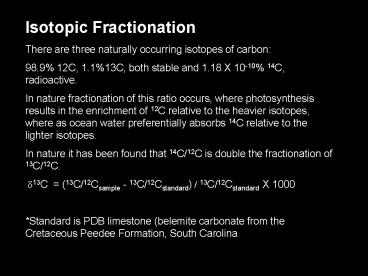Isotopic Fractionation - PowerPoint PPT Presentation
1 / 10
Title:
Isotopic Fractionation
Description:
U-Th dating of corals has extended the 14C calibration curve back to 50,000 ... rings during the spring-summer (light color) and fall-winter dark color) ... – PowerPoint PPT presentation
Number of Views:189
Avg rating:3.0/5.0
Title: Isotopic Fractionation
1
Isotopic Fractionation There are three naturally
occurring isotopes of carbon 98.9 12C, 1.113C,
both stable and 1.18 X 10-10 14C,
radioactive. In nature fractionation of this
ratio occurs, where photosynthesis results in the
enrichment of 12C relative to the heavier
isotopes, where as ocean water preferentially
absorbs 14C relative to the lighter isotopes. In
nature it has been found that 14C/12C is double
the fractionation of 13C/12C. ??13C
(13C/12Csample - 13C/12Cstandard) /
13C/12Cstandard X 1000 Standard is PDB
limestone (belemite carbonate from the Cretaceous
Peedee Formation, South Carolina
2
Organic samples are prepared for radiocarbon
dating by combusting or dissolving the organics
and producing CO2 gas. The decay activity in the
CO2 gas will be directly related to the time of
death (age) of the organic material.
3
Beta-counting laboratories, such as the one shown
above, determine 14C ages based on the measured
14C activity (decay counting) of the organic
sample. A liter of CO2 gas combusted from a
modern piece of wood (i.e., assigned to 1950 AD
and compensating for bomb and industrial
revolution effects) would have a b-decay count of
15 decays per minute. What would the decay rate
be for a piece of wood that was 5730 (1
half-life) years old?
4
Improvement in accelerator mass spectrometry
(AMS) have allowed geochronologists to directly
measure the 14C to stable carbon(12C and 13C)
ratio. The ratio of 14C to 12C or 13C will be
reduced by 50 after one half-life. AMS 14C
dating requires a much smaller organic sample
(milligrams versus grams) than the beta-counting
method. Most 14C analyses today are measured
using AMS.
5
- Source of Error in 14C dating
- Variations in geomagnetic flux. Geomagnetic
field strength partly controls 14C production in
the atmosphere because of attenuation affects on
the cosmic flux with increasing magnetic field
strength. - Modulation of the cosmic-ray flux by increased
solar activity (i.e., solar flares) leads to
attenuation of the cosmic-ray flux. - Influence of the ocean reservoir. Any change in
exchange rate between ocean reservoir and
atmospheric reservoir will affect the level of
14C in the atmosphere. - Industrial revolution (ratio of 14C to stable
carbon decreased because of burning fossil fuels)
and bomb effects (14C to stable carbon increased
because of increased neutron production from
detonation of nuclear bombs in the atmosphere)
have made modern organic samples unsuitable for
as reference samples.
6
U-Th dating of corals has extended the 14C
calibration curve back to 50,000 years (Fairbanks
et al., 2005).
7
Dendrochronolgy (tree ring counting) has been
useful for calibration of 14C ages with calendar
ages. Trees growing at latituded with seasonal
variation in temperature will produce distinct
growth rings during the spring-summer (light
color) and fall-winter dark color). The
bristlecone pine record in the White Mountains,
CA has been extended back gt10,000 years.
8
Marine Reservoir Effect The rediocarbon age of
marine carbonates will reflect the age of the
carbon in the ocean reservoir. Because deep ocean
waters are slowly mixed with surface waters, the
radiocarbon age reflects the residence time of
the carbon within the water. Deep water
production in the North Atlantic slowly cycles to
the Pacific where it upwells along the coastline
of South America and North America. The
residence time of this circulation is over 1000
years. Marine organisms living in this upwelling
water will yield radiocarbon ages that are much
older than the true age of the organism. This
reservoir effect must be know to accurately
assing 14C ages to marine shells in GMD.
Mollusk Shells
9
Radiocarbon dating is useful for assigning ages
to sediment that may incorporate organics during
erosion and deposition, such as this log present
in glacial till.
10
Radiocarbon dating is useful for assigning ages
to young (lt50,000 years old) volcanic ash layers,
such as the Mazama (Crater Lake) tephra shown
above. The above sediment core was collected
from Kachess Lake, lying east of Snoqualmie Pass,
WA.































